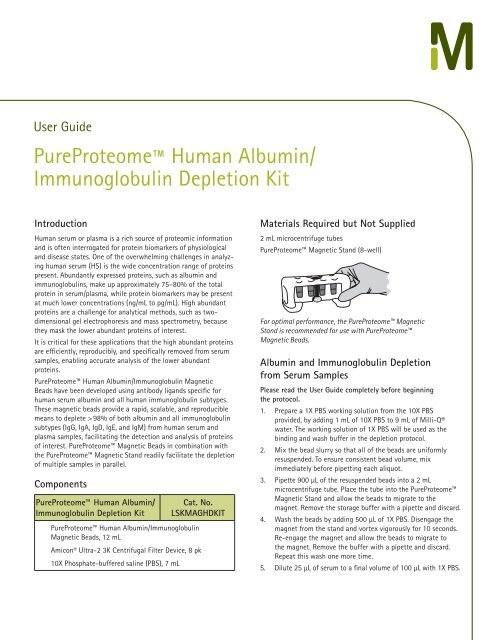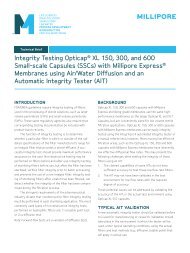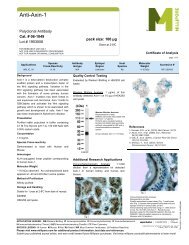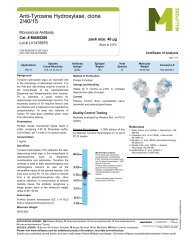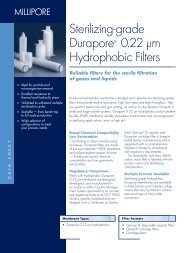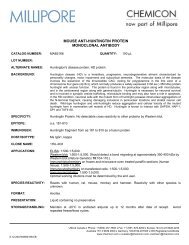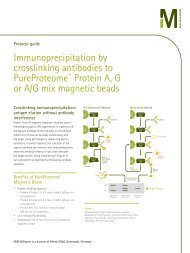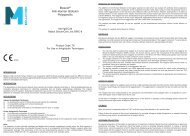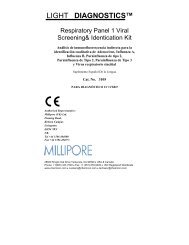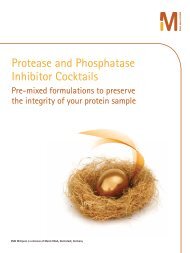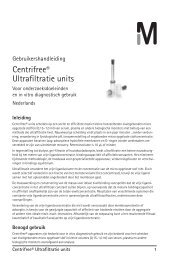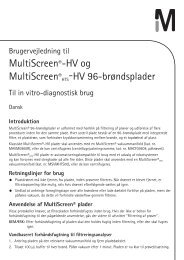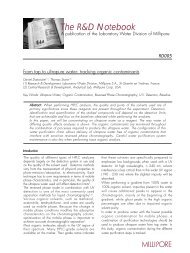PureProteome™ Human Albumin/ Immunoglobulin ... - Millipore
PureProteome™ Human Albumin/ Immunoglobulin ... - Millipore
PureProteome™ Human Albumin/ Immunoglobulin ... - Millipore
You also want an ePaper? Increase the reach of your titles
YUMPU automatically turns print PDFs into web optimized ePapers that Google loves.
LIPO<br />
User Guide<br />
PureProteome <strong>Human</strong> <strong>Albumin</strong>/<br />
<strong>Immunoglobulin</strong> Depletion Kit<br />
Introduction<br />
<strong>Human</strong> serum or plasma is a rich source of proteomic information<br />
and is often interrogated for protein biomarkers of physiological<br />
and disease states. One of the overwhelming challenges in analyzing<br />
human serum (HS) is the wide concentration range of proteins<br />
present. Abundantly expressed proteins, such as albumin and<br />
immunoglobulins, make up approximately 75–80% of the total<br />
protein in serum/plasma, while protein biomarkers may be present<br />
at much lower concentrations (ng/mL to pg/mL). High abundant<br />
proteins are a challenge for analytical methods, such as twodimensional<br />
gel electrophoresis and mass spectrometry, because<br />
they mask the lower abundant proteins of interest.<br />
It is critical for these applications that the high abundant proteins<br />
are efficiently, reproducibly, and specifically removed from serum<br />
samples, enabling accurate analysis of the lower abundant<br />
proteins.<br />
PureProteome <strong>Human</strong> <strong>Albumin</strong>/<strong>Immunoglobulin</strong> Magnetic<br />
Beads have been developed using antibody ligands specific for<br />
human serum albumin and all human immunoglobulin subtypes.<br />
These magnetic beads provide a rapid, scalable, and reproducible<br />
means to deplete > 98% of both albumin and all immunoglobulin<br />
subtypes (IgG, IgA, IgD, IgE, and IgM) from human serum and<br />
plasma samples, facilitating the detection and analysis of proteins<br />
of interest. PureProteome Magnetic Beads in combination with<br />
the PureProteome Magnetic Stand readily facilitate the depletion<br />
of multiple samples in parallel.<br />
Components<br />
PureProteome <strong>Human</strong> <strong>Albumin</strong>/<br />
<strong>Immunoglobulin</strong> Depletion Kit<br />
Cat. No.<br />
LSKMAGHDKIT<br />
PureProteome <strong>Human</strong> <strong>Albumin</strong>/<strong>Immunoglobulin</strong><br />
Magnetic Beads, 12 mL<br />
Amicon® Ultra-2 3K Centrifugal Filter Device, 8 pk<br />
10X Phosphate-buffered saline (PBS), 7 mL<br />
Materials Required but Not Supplied<br />
2 mL microcentrifuge tubes<br />
PureProteome Magnetic Stand (8-well)<br />
For optimal performance, the PureProteome Magnetic<br />
Stand is recommended for use with PureProteome<br />
Magnetic Beads.<br />
<strong>Albumin</strong> and <strong>Immunoglobulin</strong> Depletion<br />
from Serum Samples<br />
Please read the User Guide completely before beginning<br />
the protocol.<br />
1. Prepare a 1X PBS working solution from the 10X PBS<br />
provided, by adding 1 mL of 10X PBS to 9 mL of Milli-Q®<br />
water. The working solution of 1X PBS will be used as the<br />
binding and wash buffer in the depletion protocol.<br />
2. Mix the bead slurry so that all of the beads are uniformly<br />
resuspended. To ensure consistent bead volume, mix<br />
immediately before pipetting each aliquot.<br />
3. Pipette 900 μL of the resuspended beads into a 2 mL<br />
microcentrifuge tube. Place the tube into the PureProteome<br />
Magnetic Stand and allow the beads to migrate to the<br />
magnet. Remove the storage buffer with a pipette and discard.<br />
4. Wash the beads by adding 500 μL of 1X PBS. Disengage the<br />
magnet from the stand and vortex vigorously for 10 seconds.<br />
Re-engage the magnet and allow the beads to migrate to<br />
the magnet. Remove the buffer with a pipette and discard.<br />
Repeat this wash one more time.<br />
5. Dilute 25 μL of serum to a final volume of 100 μL with 1X PBS.
4 00<br />
3 00<br />
2 00<br />
1 00<br />
20<br />
4 00<br />
3 00<br />
2 00<br />
1 00<br />
20<br />
4 00<br />
3 00<br />
2 00<br />
1 00<br />
20<br />
4 00<br />
3 00<br />
2 00<br />
1 00<br />
20<br />
<strong>Albumin</strong> and <strong>Immunoglobulin</strong> Depletion from<br />
Serum Samples, continued<br />
6. Add the diluted serum sample to the washed beads. Incubate<br />
for 60 minutes at room temperature with continuous mixing<br />
or end-over-end rotation.<br />
7. A pulse in a microcentrifuge may be required if liquid has<br />
accumulated in the microcentrifuge tube cap. Place the tube<br />
back into the magnetic stand. Allow the beads to migrate<br />
to the magnet. Remove the depleted serum with a pipette.<br />
Transfer to a fresh tube and save.<br />
NOTE: This represents the albumin and immunoglobulindepleted<br />
serum sample.<br />
8. To maximize recovery of the depleted serum sample, wash<br />
the beads 3 times, using 500 μL of 1X PBS for each wash.<br />
After each wash, disengage the magnet and vortex vigorously<br />
for 10 seconds. Re-engage the magnet and allow the beads<br />
to migrate to the magnet. Remove the wash fraction with a<br />
pipette and combine with the saved depleted serum.<br />
9. Store the depleted fraction at or below -20 °C for long term<br />
storage.<br />
NOTE: The sample may be concentrated and/or desalted prior<br />
to storage.<br />
Using Centrifugation for Concentration or<br />
Buffer Exchange (Optional)<br />
Amicon® Ultra-2 3K centrifugal filter devices are provided for<br />
rapid concentration and buffer exchange/desalting of the sample.<br />
Typical processing time is 30–60 minutes to reduce the volume of<br />
a depleted sample to 50–150 µL. A physical deadstop in the filter<br />
device prevents spinning to dryness and avoids potential sample<br />
loss. Concentration and buffer exchange/desalting of the depleted<br />
serum sample can be performed in the same device. A detailed<br />
user guide for the Amicon® Ultra-2 filter device is provided.<br />
1. Add the pooled depleted serum/wash fraction sample to the<br />
Amicon® Ultra-2 filter device.<br />
2. Assemble the filter device and centrifuge per instructions to<br />
concentrate the sample to the desired volume.<br />
3. For applications that require buffer exchange or desalting,<br />
add the desired buffer and centrifuge again to concentrate<br />
the sample. Repeat this wash as required to ensure the<br />
desired exchange of buffer. For more detailed instructions,<br />
consult the Amicon® Ultra-2 User Guide.<br />
Using Centrifugation for Concentration or<br />
Buffer Exchange, continued<br />
4. Remove the assembled device from the centrifuge and<br />
separate the Amicon® Ultra filter device from the filtrate<br />
collection tube.<br />
5. To recover the concentrated solute, invert the Amicon®<br />
Ultra filter device and concentrate collection tube. Place in<br />
centrifuge and counterbalance with a similar device. Spin for<br />
2 minutes at 1,000 x g to transfer the concentrated sample<br />
from the device to the tube.<br />
NOTE: For optimal recovery, perform the reverse spin<br />
immediately.<br />
Alternatively, concentration and buffer exchange may be<br />
performed using a different method, such as protein precipitation.<br />
Elution of Proteins Bound to PureProteome<br />
<strong>Albumin</strong>/ <strong>Immunoglobulin</strong> Magnetic Beads<br />
(Optional)<br />
The bound fraction of proteins may be analyzed by SDS-PAGE to<br />
confirm recovery of target protein(s) in the unbound depleted<br />
sample.<br />
To elute the bound proteins, resuspend the beads 3 times using a<br />
minimum of 100 µL of 200 mM Glycine-HCl, pH 2.0–3.0 for each<br />
elution. After adding the Glycine-HCl, disengage the magnet and<br />
vortex vigorously for 10 seconds. Re-engage the magnet and allow<br />
the beads to migrate to the magnet. Remove the eluted fraction<br />
with a pipette and save.<br />
NOTE: Samples eluted in 200 mM Glycine-HCl, pH 2.0–3.0 may<br />
need to be neutralized by adding 1/10 the eluted sample<br />
volume of 2 M Tris, pH 8.0 (not included in kit).<br />
Alternatively, the bound proteins may be eluted in a 1X SDS-<br />
PAGE Reducing Sample Buffer (RSB). To elute the bound proteins,<br />
resuspend the beads in a minimum of 100 µL of 1X RSB. After<br />
adding the RSB, disengage the magnet and vortex vigorously for<br />
10 seconds. Remove tube and incubate at 70 °C for 10 minutes.<br />
Quickly place the tube back in the magnetic stand and allow the<br />
beads to migrate to the magnet. Immediately remove the eluted<br />
fraction with a pipette and save. Repeat two more times.<br />
NOTE: The antibody ligands (~13 MW) may be observed on the gel<br />
if the magnetic beads have been incubated in 1X RSB at<br />
70 °C for 10 minutes.<br />
Spin to<br />
concentrate<br />
Spin to<br />
concentrate<br />
10K<br />
10K<br />
10K<br />
10K<br />
Depleted<br />
serum in PBS<br />
50–150 µL of concentrated<br />
depleted serum in PBS<br />
Add 40 mM Tris<br />
exchange buffer<br />
Concentrated and bufferexchanged<br />
sample<br />
2
Performance<br />
Figure 1. Removal of <strong>Human</strong> Serum <strong>Albumin</strong><br />
and <strong>Immunoglobulin</strong> from Serum<br />
Figure 2. <strong>Human</strong> Serum Protein Analysis<br />
Pre- and Post-depletion<br />
MW<br />
200<br />
150<br />
100<br />
75<br />
50<br />
37<br />
A. Before depletion<br />
pH<br />
B. After depletion<br />
pH<br />
<strong>Albumin</strong><br />
Ig Heavy<br />
Ig Light<br />
5.2 6.5 7.5 8.5<br />
5.2 6.5 7.5 8.5<br />
1 2 3 4 5 6 7<br />
220 MW<br />
Coomassie blue-stained 2D PAGE gels of total human serum proteins (Panel A)<br />
and the fraction depleted of albumin and immunoglobulin (Panel B) using<br />
PureProteome <strong>Human</strong> <strong>Albumin</strong>/<strong>Immunoglobulin</strong> Magnetic Beads. 200 µg<br />
of total protein was resolved by isoelectric focusing (pH 3.5–10) in the first<br />
dimension and 10% SDS-PAGE in the second dimension.<br />
94<br />
60<br />
43<br />
29<br />
14<br />
220<br />
94<br />
60<br />
43<br />
29<br />
14<br />
MW<br />
Performance, continued<br />
Figure 3. Depletion Efficiency of <strong>Human</strong> Serum <strong>Albumin</strong> and<br />
<strong>Immunoglobulin</strong> Subtypes from <strong>Human</strong> Serum<br />
Specifications<br />
PureProteome <strong>Human</strong> <strong>Albumin</strong>/<strong>Immunoglobulin</strong> Magnetic Beads<br />
Matrix<br />
Particle form<br />
Bead diameter<br />
Storage<br />
Mixture of polymer-coated magnetic silica<br />
beads covalently coupled with antibody<br />
ligands<br />
Spherical<br />
10 μm (nominal)<br />
2–8 °C. Do not freeze.<br />
% Depletion > 98% albumin and immunoglobulin<br />
Typical values are > 99%<br />
Shelf life<br />
Refer to expiration date on product label<br />
PureProteome <strong>Human</strong> <strong>Albumin</strong>/<strong>Immunoglobulin</strong> Magnetic<br />
Beads are for research use only. They are not for use in<br />
diagnostic procedures.<br />
Disposal<br />
IgA IgG 1 IgG 2 IgG 3 IgG 4 IgD IgE IgM <strong>Albumin</strong><br />
Depletion<br />
Efficiency 99.79 99.94 99.91 99.98 99.83 99.99 99.11 99.92 99.98<br />
(%)<br />
25 µL human serum was mixed with PureProteome <strong>Human</strong> <strong>Albumin</strong>/<br />
<strong>Immunoglobulin</strong> Magnetic Beads (900 µL of slurry) and depleted as outlined in<br />
the protocol. The pre- and post-depleted human serum samples were assayed<br />
by ELISA (albumin, IgD, and IgE) or Luminex® assay (IgA, IgG 1, IgG 2, IgG 3, IgG 4 ,<br />
and IgM) to calculate the percent depletion.<br />
Collect and dispose of used material according to all applicable<br />
international, federal, state, and local regulations.<br />
Safety Data Sheet<br />
Safety Data Sheets (SDS) are available on our web site. Go to<br />
www.millipore.com and enter your catalogue number in the<br />
search box.<br />
25<br />
20<br />
15<br />
10<br />
Lane 1 2 3 4 5 6 7<br />
Sample<br />
Sample<br />
Volume<br />
Molecular<br />
Weight<br />
Markers<br />
4X<br />
<strong>Human</strong><br />
serum<br />
diluted<br />
Unbound<br />
(depleted<br />
fraction)<br />
Wash 1 Wash 2 Wash 3 Elution<br />
(bound<br />
fraction)<br />
10 µL 2 µL 2 µL 2 µL 2 µL 2 µL 2 µL<br />
Proteins were resolved on 4–12% SDS-PAGE gel and stained with Coomassie<br />
blue. <strong>Human</strong> serum (25 µL) was depleted of albumin and immunoglobulin<br />
following the depletion protocol described. The bound fraction was eluted from<br />
the magnetic beads using 100 µL additions of 200 mM Glycine-HCl, pH 2.5.<br />
3
Product Ordering Information<br />
Description Qty/Pk Cat. No.<br />
PureProteome <strong>Human</strong> <strong>Albumin</strong>/<br />
<strong>Immunoglobulin</strong> Depletion Kit (contains<br />
magnetic beads, buffer concentrate,<br />
and Amicon® Ultra-2 devices)<br />
PureProteome Kappa Ig Binder<br />
Magnetic Beads<br />
PureProteome Lambda Ig Binder<br />
Magnetic Beads<br />
PureProteome <strong>Albumin</strong>/IgG Depletion<br />
Kit (contains magnetic beads, buffer<br />
concentrate, and Amicon® Ultra-4<br />
devices)<br />
1 LSKMAGHDKIT<br />
2 mL LSKMAGKP02<br />
2 mL LSKMAGLM02<br />
1 LSKMAGD12<br />
PureProteome Magnetic Stand, 8-well 1 LSKMAGS08<br />
PureProteome Magnetic Stand, 15 mL 1 LSKMAGS15<br />
Amicon® Ultra-2 3K Device 24 UFC200324<br />
PureProteome <strong>Albumin</strong><br />
Magnetic Beads<br />
PureProteome Streptavidin<br />
Magnetic Beads<br />
PureProteome Nickel<br />
Magnetic Beads<br />
PureProteome Protein A<br />
Magnetic Beads<br />
PureProteome Protein G<br />
Magnetic Beads<br />
1 × 10 mL LSKMAGL10<br />
2 × 1 mL<br />
1 × 10 mL<br />
2 × 1 mL<br />
1 × 10 mL<br />
2 × 1 mL<br />
1 × 10 mL<br />
2 × 1 mL<br />
1 × 10 mL<br />
PureProteome Carboxy Flexibind Magnetic Beads<br />
0.3 µm beads 2 mL<br />
10 mL<br />
1.0 µm beads 2 mL<br />
10 mL<br />
2.5 µm beads 2 mL<br />
10 mL<br />
PureProteome NHS FlexiBind Magnetic<br />
Beads Kit (contains 0.5 mL magnetic<br />
beads, equilibration, wash/coupling, and<br />
quench buffers, and Amicon® Ultra-0.5<br />
devices)<br />
PureProteome NHS FlexiBind<br />
Magnetic Beads<br />
1<br />
4 × 0.5 mL<br />
LSKMAGT02<br />
LSKMAGT10<br />
LSKMAGH02<br />
LSKMAGH10<br />
LSKMAGA02<br />
LSKMAGA10<br />
LSKMAGG02<br />
LSKMAGG10<br />
LSKMAG03CBX02<br />
LSKMAG03CBX10<br />
LSKMAG1CBX02<br />
LSKMAG1CBX10<br />
LSKMAG25CBX02<br />
LSKMAG25CBX10<br />
LSKMAGN01<br />
LSKMAGN04<br />
Notice<br />
The information in this document is subject to change without<br />
notice and should not be construed as a commitment by EMD<br />
<strong>Millipore</strong> Corporation ("<strong>Millipore</strong>") or an affiliate. Neither<br />
EMD <strong>Millipore</strong> Corporation nor any of its affiliates assumes<br />
responsibility for any errors that may appear in this document.<br />
Technical Assistance<br />
For more information, contact the office nearest you. In the U.S.,<br />
call 1-800-MILLIPORE (1-800-645-5476). Outside the U.S., go to<br />
our web site at www.millipore.com/offices for up-to-date worldwide<br />
contact information. You can also visit the tech service page<br />
on our web site at www.millipore.com/techservice.<br />
Standard Warranty<br />
The applicable warranty for the products listed in this publication<br />
may be found at www.millipore.com/terms (within the “Terms and<br />
Conditions of Sale” applicable to your purchase transaction).<br />
The M logo and PureProteome are trademarks of Merck KGaA, Darmstadt, Germany.<br />
<strong>Millipore</strong>, Milli-Q, and Amicon are registered trademarks of Merck KGaA.<br />
All trademarks of third parties are the property of their respective owners.<br />
© 2012, EMD <strong>Millipore</strong> Corporation. All rights reserved.<br />
LSKMAGHDKIT, Rev. A, 04/12<br />
4


